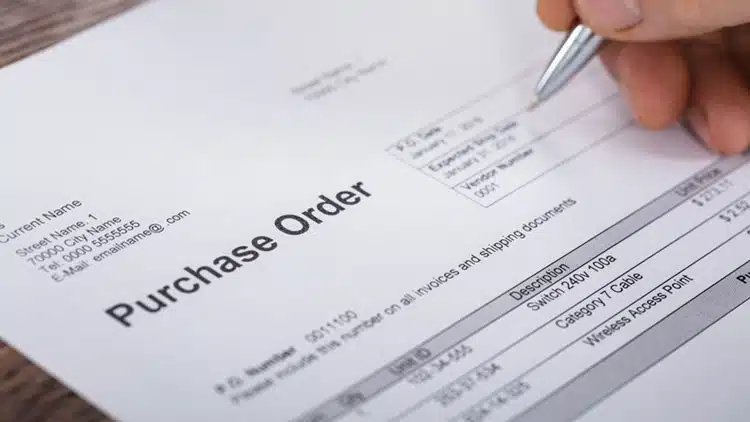Purchase order (PO) management is crucial for every business, especially those who work with vendors and suppliers continuously. If it isn’t managed properly, your company can end up dealing with costly mistakes or inefficiencies that can harm its financials and reputation. Fortunately, there are tried-and-true strategies you can use to manage purchase orders effectively. Below, we outline a step-by-step guide to managing purchase orders efficiently:
1. Invest in an Automated System
Investing in an automated system is the first step toward efficient purchase order management. Automated systems are a cornerstone of modern operational efficiency, replacing manual methods with sophisticated technology. It eliminates the risk of human errors often associated with manual entry and streamlines the procurement process, improving accuracy and speed.
In addition, it offers real-time visibility of data, enabling companies to track their orders at any stage, leading to improved accountability and transparency. You can read more about the best purchase order software available and how it can help your business. Moreover, automated systems also save valuable time and resources, allowing staff to focus on more strategic tasks, thus driving overall business productivity.
2. Establish Clear Guidelines and Expectations
These guidelines should encompass every aspect of the purchase order process, ranging from who can create purchase orders to who approves them and under what circumstances. Clear expectations set a benchmark for vendor performance, ensuring the quality and delivery times meet the agreed-upon standards. They also aid in conflict resolution and facilitate smooth communication between your company and the vendors.
The guidelines should also cover how to respond to vendor requests, when a purchase order is to be canceled, and the process. Lastly, investing in an automated system can make it easier to maintain regulations and comply with government rules regarding purchase orders.
3. Regularly Review Existing Policies
As your company evolves and grows, you may need to tweak existing policies to ensure they are up-to-date and relevant. This means ensuring that the guidelines established previously are still effective and meet current needs while considering any legal landscape changes. Reviewing existing policies regularly and adapting them (if necessary) is essential to successful purchase order management.
By doing so, the company can stay ahead of potential issues, mitigate risks, and continuously improve the efficiency of its purchase order management. Moreover, regular policy reviews facilitate proactive rather than reactive decision-making, aiding in identifying and rectifying any operational inefficiencies, thereby contributing to enhanced business performance and growth.
4. Analyze and Optimize
After streamlining the purchase order process, analyze it regularly to identify any areas that can be further optimized. This step is essential for ensuring your company’s operations run smoothly and efficiently. For example, you can start by reviewing the vendor performance criteria; if there have been any changes in expectations or regulations, consider them while analyzing the process.
You can also evaluate average delivery times and quality of received goods and services to detect any issues. You may need to find a new vendor or renegotiate the existing agreement if there are any discrepancies. Additionally, you can use analytical tools such as data analysis and dashboards to gain insights into purchasing patterns. This can help you identify areas where costs could be reduced, or better terms could be negotiated with vendors.
5. Ensure Proper Documentation
Maintaining documents such as invoices, delivery notes, and bills of lading is key to successful purchase order management. Having clear documentation can help you track all your purchases and monitor the performance of vendors more accurately. It also enables you to resolve disputes or billing errors with minimum effort easily.
In addition, proper documentation is vital when it comes to auditing and compliance. Ensuring all the documents are in order prevents potential issues related to tax, contracts, or legal considerations. Lastly, comprehensive document filing allows for better tracking of the entire ordering process, thus ensuring smoother business operations.
6. Invest in Training
Training your staff on the best practices for purchase order management is essential for successfully implementing the process. This includes training them on using the automated system and explaining why and how specific policies are implemented. Additionally, staff should be informed about changes to existing policies and guidelines.
Furthermore, in-depth product training should be available for staff members dealing with vendor performance. They should know how to use the system to review delivery time, quality of goods or services received, and other related metrics. An investment in proper training helps ensure that everyone is on the same page regarding purchase order management, thus improving overall efficiency.
When implementing these steps, remember to use the right tools and technologies to ensure your company’s purchase order management process is as streamlined and efficient as possible. Automated systems can significantly reduce manual effort, enable real-time data visibility, and help staff focus on more strategic tasks. They also provide an audit trail, allowing for better tracking of every step in the purchasing process. Investing in the right technology can go a long way in helping you achieve success with your purchase order management.
Lucas Noah, armed with a Bachelor’s degree in Information & Technology, stands as a prominent figure in the realm of tech journalism. Currently holding the position of Senior Admin, Lucas contributes his expertise to two esteemed companies: OceanaExpress LLC and CreativeOutrank LLC. His... Read more
